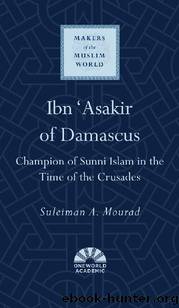Ibn 'Asakir of Damascus: Champion of Sunni Islam in the Time of the Crusades (Makers of the Muslim World) by Suleiman A. Mourad

Author:Suleiman A. Mourad [Mourad, Suleiman A.]
Language: eng
Format: epub
Publisher: Oneworld Publications
Published: 2021-08-05T00:00:00+00:00
Arrangement and Divisions
Ibn âAsakir arranged the Taârikh in the following order. The first two volumes, as mentioned earlier, were dedicated to the description of Damascus and its environs, which included some narratives about the Islamic conquests of Syria and about the religious merits of many spots and structures in the city and in its vicinity. He then designated the two following volumes for the Prophet Muhammad. After that, he arranged the biographies according to the Arabic alphabet, starting with the letter aleph (A) and ending with the letter yaâ (Y). Under each letter, he listed the biographies in alphabetical order, though for the letters A and M he started with those named Ahmad and Muhammad respectively because of their honor of place, being the names of the Prophet. He did the same with the category of names âAbd, where he started with âAbd Allah because Allah is the name of God, whereas the others are his epithets. Following that, Ibn âAsakir earmarked three volumes for those men who were only known through an honorific or nickname, or were unknown except for being mentioned in some sources as having lived or passed through Damascus and Syria. Finally, the last two volumes were designated for women of various social and religious importance.
There were two divisions of the Taârikh. The original division, which partitioned the text into 570 fascicles, and the expanded division, which divided it into 800 fascicles. The latter was prepared by al-Qasim during the lifetime of his father and under his supervision, but he only circulated it after his father had died. Indeed, we find confirmation about the two divisions in the short biography that al-Qasim did for his father, which is preserved in Yaqut al-Hamawiâs Muâjam al-udabaâ, where he mentioned both versions. They are also attested in the different manuscripts of the Taârikh where we find mention of both divisions, sometimes simultaneously in the same manuscript, in the colophons about the various teaching sessions held to disseminate the text, the locations where they occurred, and the names of those who were in attendance. For instance, a note in one manuscript (volume 63 in Dar al-Fikr edition) specifies the text as coming from fascicles 502â509 of the original division, whereas another remark in another manuscript (volume 62 in the same edition) associates the text with fascicles 701â710, which formed volume 71 of the expanded division.
This is further corroborated by âImad al-Din al-Isfahani who said in his Kharidat al-qasr that he saw a copy of the Taârikh shortly after his arrival in Damascus in 562/1166, and asked Ibn âAsakir to teach him a few parts from it. He stated that Ibn âAsakir told him the book reached 700 fascicles, each containing 20 folios. This actually gives us a relatively specific dating as to when work on the expanded version started. If we understand that the shorter version was first circulated in 559/1164 (as discussed below), and Ibn âAsakir showed âImad al-Din al-Isfahani an unfinished version of 700 fascicles in 562/1166, then the work on the expanded version must have started around 560/1165.
Download
This site does not store any files on its server. We only index and link to content provided by other sites. Please contact the content providers to delete copyright contents if any and email us, we'll remove relevant links or contents immediately.
The History of Jihad: From Muhammad to ISIS by Spencer Robert(2575)
Nine Parts of Desire by Geraldine Brooks(2329)
The Turkish Psychedelic Explosion by Daniel Spicer(2315)
The First Muslim The Story of Muhammad by Lesley Hazleton(2223)
The Essential Rumi by Coleman Barks(1993)
1453 by Roger Crowley(1975)
The Last Mughal by William Dalrymple(1835)
Trickster Travels: A Sixteenth-Century Muslim Between Worlds by Davis Natalie Zemon(1817)
God by Aslan Reza(1617)
Muhammad: His Life Based on the Earliest Sources by Martin Lings(1612)
by Christianity & Islam(1596)
A Concise History of Sunnis and Shi'is by John McHugo(1548)
Magic and Divination in Early Islam by Emilie Savage-Smith;(1502)
No God But God by Reza Aslan(1500)
The Flight of the Intellectuals by Berman Paul(1467)
Art of Betrayal by Gordon Corera(1404)
Nothing to Envy by Barbara Demick(1390)
What the Qur'an Meant by Garry Wills(1363)
Getting Jesus Right: How Muslims Get Jesus and Islam Wrong by James A Beverley & Craig A Evans(1314)
